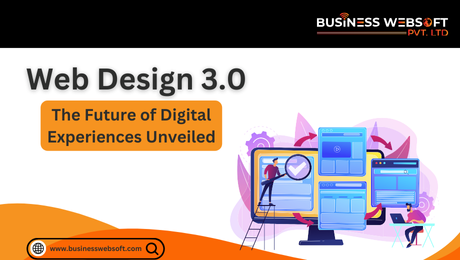The digital panorama is evolving rapidly, and web layout isn’t an exception. As we input 2025, Web Design 3.0 is rising as the brand new widespread, blending creativity with modern-day generation to deliver immersive and engaging consumer stories.
Web Design 3.0 specializes in personalization, dynamic interfaces, and better human interplay, making sure websites aren’t just functional but unforgettable. In this weblog, we will discover the important traits, techniques, and techniques that outline Web Design 3.0 and how businesses can leverage them to captivate their audiences.
What is Web Design 3.0?
Web Design 3.0 is the evolution of modern web layout standards. It combines AI-pushed personalization, interactive UI elements, voice-enabled surfing, and immersive visuals to create intuitive and engaging digital stories.
The purpose? Turning visitors into energetic contributors.
Key Features of Web Design 3.0
Here are the defining elements that set Web Design 3.0 apart:
1. Dynamic Personalization with AI
AI algorithms now play an essential position in web layout by way of studying consumer behavior to deliver personalized content material, product guidelines, and layouts.
✅ Example: E-trade platforms like Amazon dynamically modify homepage content primarily based on surfing records, increasing engagement and conversions.
2. Micro-Interactions for Enhanced UX
Small but impactful animations — such as hover outcomes, button animations, or scrolling signs — improve consumer engagement and guide site visitors through the website.
✅ Example: Social media structures use heart animations, swipe results, and reaction buttons to boost interactivity.
3. Voice User Interface (VUI)
Voice seek and clever assistants are transforming how customers engage with websites. Web Design 3.0 integrates VUI for seamless navigation, in particular for cellular customers.
✅ Example: Food transport apps now allow users to locate orders through voice commands, enhancing comfort.
4. Immersive 3-D Elements
Websites are adopting 3-D images, parallax scrolling, and interactive animations to create depth and visible appeal.
✅ Example: Architecture companies showcase virtual 3-D walkthroughs of homes for immersive surfing.
5. Dark Mode for Modern Aesthetics
Dark mode is turning into a web design staple, presenting a graceful appearance while reducing eye stress and enhancing clarity.
✅ Example: Popular apps like Instagram, YouTube, and Spotify have applied darkish mode for progressed UX.
6. Neumorphism Design Trend
This layout fashion blends flat design with 3-D effects, developing soft shadows and highlights that mimic physical gadgets — giving buttons, cards, and bureaucracy an extra tactile experience.
✅ Example: Finance and productiveness apps increasingly adopt neuromorphic designs to decorate visual hierarchy.
7. Inclusive and Accessible Design
Web Design 3.0 emphasizes inclusivity, ensuring websites are available to humans of all competencies with functions like:
Voice descriptions for photographs
Keyboard navigation alternatives
Contrast-more desirable textual content for readability
✅ Example: E-commerce manufacturers are imposing inclusive layout factors to expand their patron base.
Web Design 3.0 Best Practices
To create an effective Web Design 3.0, comply with these key strategies:
✅ Focus on Speed Optimization:Use lazy loading, compressed photos, and optimized code to make sure rapid page-loading instances.
✅ Prioritize Mobile-First Design: With cell visitors dominating the internet, designs need to adapt seamlessly across numerous display sizes.
✅ Incorporate Interactive Storytelling: Web Design 3.0 leverages animations, scroll-caused content, and multimedia to interact with site visitors with fascinating narratives.
✅ Embrace Minimalism with Bold Typography: Clean designs with significant, impactful textual content improve visible hierarchy and ensure customers’ consciousness of key messages.
✅ Leverage Data for Personalization: AI gear can analyze consumer conduct to tailor suggestions, enhancing conversion quotes.
Industries Benefiting from Web Design 3.0
1. E-trade: Dynamic product suggestions, chatbots, and customized purchasing studies improve sales.
2. Real Estate: 3-D digital excursions and interactive asset layouts beautify the surfing experience.
3. Hospitality: Immersive visuals, reserving integrations, and personalized tips improve personal engagement.
4. Healthcare: AI-powered chatbots offer immediate medical advice, while interactive appointment booking structures beautify convenience.
The Future of Web Design 3.0
The next section of the internet layout will retain to embrace improvements like:
🔹 AI-Generated Visuals: AI tools that create unique internet site layouts based totally on consumer alternatives.
🔹 Augmented Reality (AR) Integration: AR-more desirable product previews for e-trade and retail.
🔹 Gesture-Based Navigation: Websites that reply to hand movements or facial reputation.
Conclusion
Web Design 3.0 is more excellent than just aesthetics — it’s approximately growing significant and noteworthy digital reviews. By combining AI-pushed personalization, immersive visuals, and intuitive navigation, companies can capture attention and enhance consumer engagement.
As we pass into 2025, embracing Web Design 3.0 might be crucial for businesses trying to stand out in the virtual panorama.
Are you prepared to revolutionize your internet site with Web Design 3.0? 🚀
